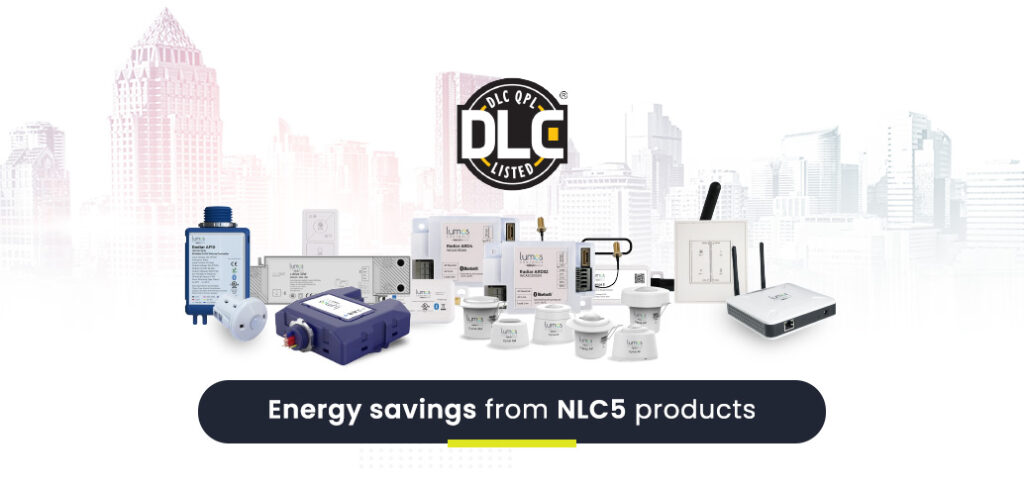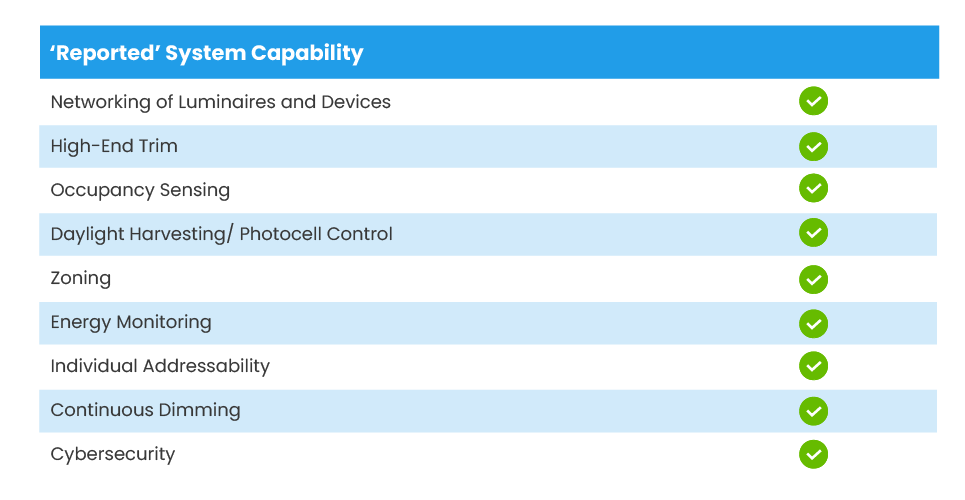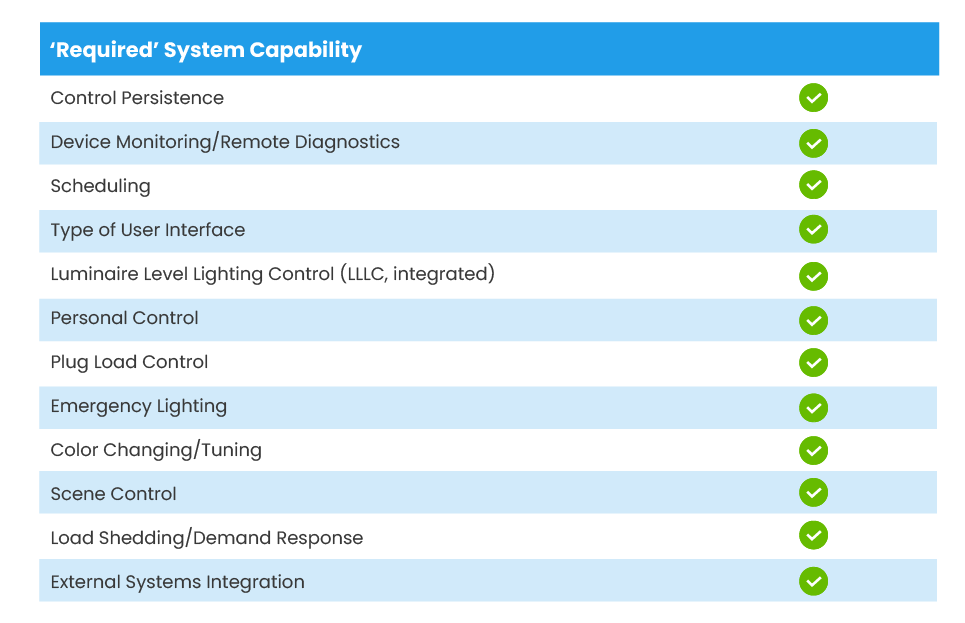Save Big on Lighting Energy Bills with DLC’s Latest NLC5 Standard

As new lighting control products are coming into the market, it is sometimes hard for specifiers or building owners to determine the best. However, organizations like DesignLights Consortium (DLC) make it easier for us, especially with premium standards for Networked Lighting Control listings (NLCs).
DLC’s NLC lighting standards version 5 encourages the lighting industry to focus on continuous improvement in energy efficiency and lighting quality. DLC-qualified products can benefit businesses by saving energy, cutting electricity costs, and taking part in rebates.
But what exactly does DLC certification mean for the lighting and building community? How does this increase customer satisfaction and confidence?
In this blog, we will take a closer look at how Lumos Controls satisfies DLC’s NLC criteria and what this means for its customers.
Let’s dive in.
DLC NLC listed products: The key to future lighting energy savings?
The “DLC approved” label on a lighting product is an endorsement of its high level of quality, performance and energy efficiency. The listed products undergo careful evaluation and verification processes to meet DLC’s technical requirements. Designers, specifiers, distributors, contractors, program administrators, and end-users can identify and compare and select rebate-eligible, high-performing control systems for their projects.
Why choose NLC certified product?
If you’re looking for the most energy-efficient lighting products available, you may find it helpful to look at NLC approved products.
Top benefits of choosing DLC NLC certified product includes:
Product quality: DLC’s NLC5-approved products have been tested and verified to meet the highest industry standards for quality and efficiency. That will give the customer peace of mind about having quality lighting solutions in their facility.
Energy efficiency: Average energy savings from the installation of networked lighting control systems are estimated to be 47 percent as more energy is converted into actual output.
Cost savings: DLC listed products consume less energy resulting in great cost savings for a facility.
Healthier environment: Energy-efficient lights radiate less heat energy and harmful toxins (UV, mercury) into the environment.
Better lighting: As DLC listed products provide good illumination, they contribute to employee safety, productivity, and end-product quality.
Rebates: With DLC NLC5 certification, you will be able to launch products eligible for utility incentives and rebates quickly.
rom the installation of networked lighting control systems are estimated to be 47 percent as more energy is converted into actual output.
Cost savings: DLC listed products consume less energy resulting in great cost savings for a facility.
Healthier environment: Energy-efficient lights radiate less heat energy and harmful toxins (UV, mercury) into the environment.
Better lighting: As DLC listed products provide good illumination, they contribute to employee safety, productivity, and end-product quality.
Rebates: With DLC NLC5 certification, you will be able to launch products eligible for utility incentives and rebates quickly.
At Lumos Controls, our products meet and exceed these standards. Specifically, our products not only fulfill the mandatory requirements set by the DLC’s NLC5 technical requirements, but they also report additional system features and benefits that go above and beyond the required criteria.
A DLC qualified product list is required to have following capabilities:

Lumos Controls go beyond the mandatory features required by the DLC’s NLC5 technical requirements and report additional system capabilities that can significantly enhance the performance of your project. These capabilities include device monitoring to ensure optimal performance, plug load control for energy efficiency, emergency lighting for safety, color tuning to enhance the ambiance, demand response to reduce costs, and external system integration for streamlined management. DesignLights Consortium Introduces Interoperability as an important asset. Lumos Controls satisfies Interior Lighting System Capabilities Focused on Interoperability

Adding more value to NLC with 3 interoperability features
Lumos Controls satisfies NLC interoperability criteria such as:
Energy Monitoring
One of the DLC’s new NLC requirements includes new recommendations for energy monitoring capability, which can help utilities scale their programs.
NLCs installed with the ability to report on energy consumption can collect data for various purposes, communicate with other building systems, and work directly with facility managers via a dashboard or phone app.
Energy monitoring can help utility efficiency programs be better designed, end-users be more informed about product effectiveness, and manufacturers be held responsible for their energy efficiency claims.
Lumos Controls energy reports collect data from various devices, including controllers, drivers, and sensors, and use it to generate meaningful reports and analytics. This allows you to better understand your building’s energy consumption, space utilization, device usage, and emergency monitoring.
External Systems Integration
The NLC5 External Systems Integration feature allows data from various NLC components such as luminaires, sensors, and controllers to be accessed through an API or BMS. This data can then be utilized by other building systems to enhance their operational efficiencies
Lumos Controls leverages the open and flexible Niagara framework, which can easily integrate with 120+ BMS protocols. BMS can utilize smart sensors for other building operations like air conditioning, heating, and security systems, together with lighting , further enhancing your building’s intelligence and efficiency.
Load Shedding/Demand Response,
A building adjusts energy consumption in response to a demand response signal or real-time price update from an electric utility.
Requires two-way communication where the building shares current and forecasted energy usage patterns with a demand control originator.
At Lumos Controls, we implement OpenADR to make the demand response program more efficient for customers. OpenADR technology allows utility companies to automatically send signals to buildings to adjust their energy usage. This way, we can conserve energy and reduce the chances of blackouts.
Choose the best!
DLC-approved products provide a high level of quality, performance, and energy efficiency, making them a great choice for businesses looking to save energy and cut electricity costs. Lumos Controls not only meets the mandatory requirements set by the DLC’s NLC5 technical requirements but also goes beyond them to offer additional system features and benefits that significantly enhance the performance of projects. Lumos Controls’ interoperability features, such as energy monitoring, external systems integration, and load shedding/demand response, add even more value to DLC’s NLC5 standard, making their products a great choice for customers looking for quality lighting solutions.
Browse our wide selection of DLC-listed lighting products, or contact us so we can answer any of your questions.